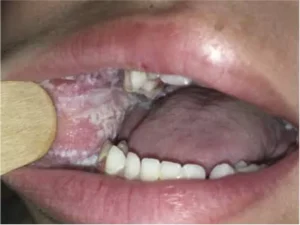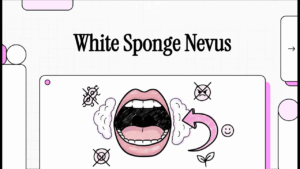1. Introduction: What is White Sponge Nevus?
This guide is designed to help you understand White Sponge Nevus (WSN), a harmless and rare condition that affects the moist linings of the body, most commonly inside the mouth. WSN may look unusual, but it is important to know that it is not a sign of a serious illness. This section will explain what the condition is, what it looks like, and why it is not a cause for alarm.


Podcast:
Learn More About White Sponge Nevus
WSN appears as patches, or lesions, that have very distinct characteristics. These patches are:
- Appearance: Soft, white, and raised from the surrounding tissue.
- Texture: Folded and spongy, which gives the condition its name.
- Adherence: Firmly attached to the lining of the mouth. A key feature of WSN is that these patches cannot be scraped or peeled off.
- Location: Most commonly found on the inside of the cheeks, often on both sides (bilaterally). However, it can sometimes appear on other moist linings, such as those in the nose, esophagus, or genital area.
It is essential to understand that White Sponge Nevus is a benign (harmless) condition. The following sections will provide more detail about its cause and why it does not pose a threat to your health.
2. The Cause of Your Condition: It’s in Your Genes
Understanding the cause of WSN is an important step in managing the condition, as it clarifies that it is not an infection you can catch or spread, nor is it the result of any personal habits.
White Sponge Nevus is a genetic condition. It is caused by a small change, or mutation, in the genes that provide the instructions for making specific proteins called keratin 4 and keratin 13. Think of keratin as the body’s building material. Just as certain types of keratin build your hair and fingernails, keratin 4 and 13 are specialized types used to build the soft, protective linings inside your mouth and nose.
The reason WSN only affects specific areas is that keratin 4 and 13 are only produced in the mucous membranes—the moist linings—of the mouth, nose, esophagus, and anogenital regions. The genetic change causes these linings to develop incorrectly, resulting in the characteristic white, spongy patches.
Because the condition is genetic, it often runs in families, which is a primary factor in determining who is at risk.
3. Understanding Your Risk Factors
Understanding the risk factors for White Sponge Nevus can help clarify how the condition is passed down and why you or a family member might have it.
The primary risk factors for developing WSN are straightforward and are almost entirely related to genetics.
- Family History: The main risk factor is having a parent with the condition. WSN is inherited as an “autosomal dominant” trait. In simple terms, this means that a child of a parent with WSN has a 50% chance of inheriting the gene and developing the condition.
- Sporadic Cases: In some rare instances, the condition can appear in individuals who have no family history of WSN. This occurs when a new, spontaneous genetic mutation happens.
Some medical literature also suggests that the condition may be diagnosed slightly more often in females than in males, though the primary risk factor remains a direct family link.
Knowing your risk factors can be helpful, but the most important thing to know is what you can do about the condition itself.
4. Management and Outlook: What You Need to Know
Because White Sponge Nevus is a harmless condition, the focus of management is on understanding and reassurance, not on aggressive medical treatment. This section outlines what you can expect in terms of managing WSN and its long-term outlook.
The most important step is getting an accurate diagnosis from a doctor. This is a critical step because WSN can sometimes resemble other conditions, like oral thrush. An accurate diagnosis confirms that the white patches are not caused by an infection and provides certainty, preventing unnecessary treatments like antifungal medications. This is why your doctor may have noted that the patches cannot be scraped off—it’s a key clinical clue that points away from a common infection like thrush and towards WSN. For the vast majority of people, treatment is not necessary.
In cases where a patient requests treatment, some options can provide temporary control of the lesions, but they are not a cure. Prescription antibiotics, such as a tetracycline mouthwash, can sometimes reduce the appearance of the patches. However, the condition usually returns after treatment stops. It is important to know that the primary and recommended approach requires no prescription medication.
The long-term outlook for anyone with WSN is excellent. The condition does not pose any health risks, and you can expect to live a normal, healthy life. Here are the most important facts to remember:
- It is benign: WSN is not a form of cancer and will not develop into oral cancer.
- It is not an infection: You cannot pass WSN on to others in any way.
- It is stable: The condition typically persists for life but is generally asymptomatic, meaning it does not cause pain or other symptoms.
